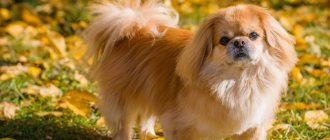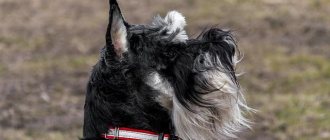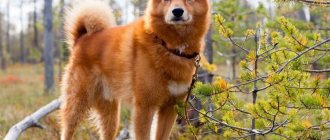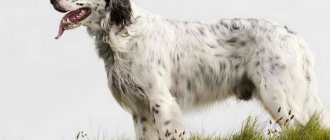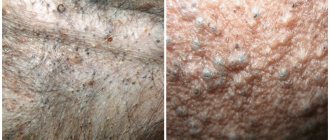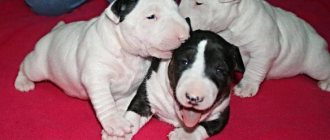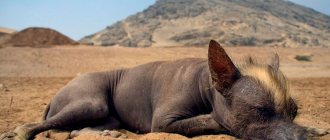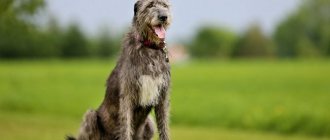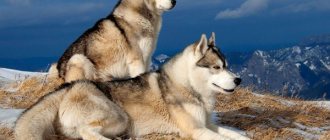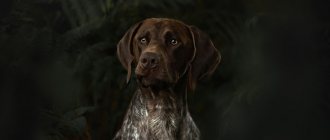Being one of the varieties of huskies, the Karelian bear dog was bred to help hunters find the animal. This breed can well be called northern. It was developed in Finland more than 100 years ago.
The ancestors of the Karelian bear dog inhabited the northern forests from ancient times, long before people appeared there...
Having a characteristic strong bone structure and muscular body, males of these black and white dogs can grow up to 54-60 cm, while the more compact females can grow up to 48-53 cm.
The normal weight of dogs of this breed ranges from 20 to 25 kg. Quite light for such a height, isn’t it?
This is due to the working qualities of the Karelian bear - its task is to run quickly and easily in order to drive the animal while hunting.
Photo 1. A typical representative of the Karelian bear dog
The head has the shape of a blunt wedge and is of medium size, proportional to the size of the body. On the head there are medium-sized ears set quite high, similar to the ears characteristic of huskies. The ears are rounded at the top.
Another external similarity between the Karelian bear and huskies (for example, with the West Siberian husky) is the curled tail, which must be fluffy.
As an exception, the standard of this hunting dog breed allows the birth of bob-tailed puppies in the litter (their number in the litter should not be more than 15%).
The eyes are dark brown and small. When viewed from certain angles, it may appear to the observer that the dog is smiling. But this is unlikely (we’ll look at the character of Karelian bear huskies a little later).
The shape of the muzzle and the appearance of the dog as a whole can resemble a fox in appearance.
In general, the size of the “Karelian” can hardly be called ideal from the point of view of proportions - the dog has a length that is slightly, but exceeds its height at the withers.
The Karelian Bear standard describes only one type of color for these dogs - black with white “inserts”, which should be located in certain places: the inside of the neck, chest, tip of the tail and spots on the face that form a mask.
As an exception, the “wolf” type of color of dogs of this breed is allowed - in such dogs the predominant color should be white with black tan.
The life expectancy of such pets with proper care can be up to 15 years.
Breed card
- Known breed names: Karelian Laika, Karjalankarhukoira, Karelian Bear Laika, Karelsk Björnhund, Karjalankarhukoira
- FCI breed number: 48
- Description of the standard on the FCI website: link
- Height at the withers: females - up to 52 cm, males - up to 57 cm
- Weight of an adult dog: males - up to 28 kg, females - up to 20 kg
- Color options: black with white markings
- Lifespan: up to 15 years
- Puppy cost: 35,000-60,000 rubles
- Size: 4 out of 5
- Learning ability: 2 out of 5
- Attitude towards children: 4 out of 5
- Shedding intensity: 5 out of 5
- Protective and guard qualities: 1 out of 5
Health and life expectancy
Laika is a wonderful dog, with strong immunity, raised in a rather difficult climate. It tolerates frost well, but you should pay close attention to it in the hot season. Avoid overheating and prolonged exposure to open sun.
There is only a predisposition to:
- Allergic reactions;
- Gastrointestinal diseases;
- Vision problems in adulthood;
- Diseases of the musculoskeletal system.
They rarely get sick, and diseases occur more likely in older and older people.
- Life expectancy: 14 – 16 years.
Characteristic
The Karelian Bear belongs to the laikoid type of the group of primitive breeds. It is used in hunting large animals, with the goal of keeping it. The dog is perfectly oriented in the area and is not capable of getting lost. In the northern countries, working tests are carried out for representatives of the breed.
FCI breed standard: No. 48
The Karelian Laika is a medium-sized dog, but has a strong build. She is balanced and fearless, she is very viscous when hunting, that is, persistent. The dog's head is triangular when viewed from behind, the skull is wide, with a slightly pronounced occipital protuberance. The groove on the forehead is almost invisible, and so are the brow ridges. The stop is stretched and rises towards the skull area. The muzzle is wide and deep, tapering towards the nose and ending with a black lobe. The lips are thin, well covering strong jaws and symmetrically developed teeth. The bite is tight, scissor-shaped.
The eyes of the Karelian Bear Dog are small, oval-shaped and brown in color. A yellow tint to the eyes is unacceptable. Erect, triangular ears with rounded tips are set high on the head.
The neck has a good arch and is covered with a rich “collar” of hair. The withers are pronounced, there is no dewlap. The line of the withers descends to a straight back with a short loin and passes into the croup, slightly sloping. The chest is voluminous and long, reaching down to the elbows, the hemline is smooth, and the belly is tucked in. Chest depth – 0.5 of the dog’s height, body length slightly exceeds height,
On the rump there is a high-set tail, wrapped in a ring. Bobtail is acceptable.
The legs of the Karelian Laika are strong and muscular: the front legs are parallel with long forearms, the hind legs are with wide hips and low hocks. The dog moves freely, covering the space widely, and easily breaks into a gallop.
Flaws:
- light frame;
- narrow muzzle or skull;
- straight tail;
- pendant around the neck;
- excessively deep sternum;
- wave wool;
- flat paws;
- predominance of white color in color;
- yellow eyes, eyesore;
- drooping ears;
- aggression towards people.
A dog with deficiencies and deviations from the standard is discarded and excluded from breeding.
Karelian Bear Dog: standard, history, care
Dimensions, weight and height of the breed
The Karelian Laika breed standard clearly states the permissible size and weight.
Ideal Bear Dog Height:
- 52 cm – females;
- 57 cm – males.
Deviations are allowed no more than 3 cm in any direction.
Optimal weight: 25-28 kg for males and 17-20 kg for females.
Possible colors
The Karelian Laika has thick, wrinkle-free skin and dense fur. The guard hair is straight and hard to the touch. On the back, neck and hips the fur is slightly longer than usual. The undercoat is thick and soft – “downy”.
The only color option for representatives of the breed is black, sometimes with a hint of brown. There are characteristic white markings on the head, chest and paws.
Puppy weight by month
Karelian Bear Dog puppies develop quickly and reach the weight of an adult dog by the age of eight months. Then growth slows down, and the puppy grows in width.
Monthly ratio of age and weight of puppies:
- 1 month – 2 kg;
- 3 months – 10-16 kg
- 6 months – 16-21 kg
- 9 months – 18-23 kg;
- 12 months – 20-25 kg.
The indicators are individual for each dog, so it is better to focus on the fatness and appearance of the puppy.
Lifespan
The Karelian Bear Dog is distinguished by excellent health. She lives up to 15 years with good care. Retains working qualities up to 9-10 years, in old age she remains cheerful and cheerful.
Allergenicity
The Karelian Laika practically does not smell like a dog, which is why it is mistakenly called hypoallergenic, forgetting about its dense undercoat, which sheds profusely twice a year. The fur of any dog can cause allergies, and dust particles accumulating in the downy layer can increase the development of the disease. You can make sure that a reaction does not occur by taking a RAST blood test and identifying dangerous allergens.
Karelian Bear Dog: photo, character and description of the breed
History of the breed
The origin of the Karelian bear dog is associated with a legend that its ancestor is an ancient deity in the guise of a bear, a totem from Finnish mythology. It was believed that from him the dog inherited calmness, confidence, a fighting spirit and a brown shade of fur. Puppies born with short tails reminiscent of a bear's were especially revered.
In fact, the Karelian dog originated from primitive northern breeds mixed with Arkhangelsk huskies. She was versatile - she could endurely drag a sled with luggage or track down prey. Thanks to the efforts of breeders, the breed gained popularity a year after its appearance and was ready to be recognized by the world community of dog handlers. In 1934, a breed club was created and documents were submitted to the FCI. But the adoption of the standard was delayed by the Second World War. By 1945, the herd numbered only 40 dogs. Enthusiasts managed to revive the breed, and in 1946 it was officially included in the classification of the International Canine Federation.
After the war, kennels of Karelian bear dogs were opened in Germany, Sweden and the northern countries. Today they are also bred in Russia, used only for hunting.
Character
The Karelian dog is a faithful assistant to the hunter; it has a fierce and excitable disposition. This character has been developed over many years of conscious selection, because the dog must hold a large animal until a person appears. It starts up easily, gets involved in the pursuit process and does not give up even in an unequal battle.
The bear husky is absolutely unsuitable as a city companion and family friend - its behavior excludes the possibility of living in the city. The ideal home for such a dog is a country house, with a large plot of land and a spacious enclosure, and the best pastime is hunting with the owner.
The dog sincerely loves the owner and family members, dominates other animals, starting regular fights. She should be the only dog in the house, and it is better to isolate livestock, cats and small animals.
The husky has an independent character and huge reserves of energy. The dog needs regular walks in a forest area, away from civilization. There is a tendency to run away due to a developed sense of smell and pursuit instinct.
Vaccinations
Vaccination is the most reliable means of protecting a dog from viral diseases. A puppy separated from its mother loses antibodies that enter the body with mother's milk. This is where the vaccine comes to the rescue.
The first vaccination begins from 8 weeks of age until one year. Before vaccination, the puppy is wormed and fleas are removed. At the time of vaccination, the dog must be completely healthy.
Attention! The gap between the first vaccination and the next one should be 3 weeks. Before starting contact with other dogs, after the second vaccination you must undergo a ten-day quarantine. This is the period when the body develops immunity to diseases
At this time, the animal’s immunity weakens; veterinarians do not even recommend bathing the dog
This is the period when the body develops immunity to diseases. At this time, the animal’s immunity weakens; veterinarians do not even recommend bathing the dog.
Healthy baby waiting for vaccinationLearning ability
Training a Karelian bear is a complex process. The dog is taught a general course and basic commands are reinforced, then they are accustomed to loud sounds and training begins. Training should be regular, and commands should be practiced until they become automatic. Laika is stubborn and obeys only a self-confident owner, demanding and strong. If this is your first dog, be sure to train with a dog handler.
Early socialization of the puppy is very important - it needs to be introduced to other animals and people in order to reduce manifestations of aggression in older age. At the sight of prey, huskies, even small ones, experience instinctive rage, so it is necessary to patiently explain who should not be touched. Aggression towards people must be stopped. Screaming and the use of force in training are unacceptable - the dog perceives them as signs of cowardice.
A bear husky, trained and fulfilling its purpose, usually does not cause problems for the owner.
Karelian Bear Dog breed characteristics, photo
Training and education
Hunting breeds and Karelian bear, needs early training and socialization from 2 months of age. Moreover, the training should be extremely careful, it is better if you already have experience. Laka will not tolerate rudeness, aggressiveness or shouting, and can sometimes be stubborn.
The owner must have sufficient patience, perseverance and calmness, only in this way will he become the leader of the husky. The dog is quite independent and independent, which affects his behavior; sometimes he can refuse to cooperate, especially if he is forced. But, if contact is established, any word of the owner is perceived as law. He obeys immediately, thereby showing respect and recognition.
For primary socialization, you will need to teach the puppy:
- To your nickname;
- Wearing a collar, leash;
- Loud sounds, strangers, other animals;
- Cars, noisy streets and roads.
Then proceed to the basics of training, learn the first commands:
- It is forbidden;
- Sit;
- Lie;
- Place.
When he gets used to it and grows a little, you can begin more complex training. The training of a young hunter begins with accustoming him to a command by which he will understand that the work has begun. They are naturally capable of picking up a scent, as well as catching or blocking an animal in cover.
Remember that when just walking, you need to carefully let him off the leash, otherwise he may run away, obeying the hunting instinct, if he smells someone.
Classes should be regular, systematic and long-term. But do not forget that the pet must also relax, it needs active games and running. Play with him more often together, include a sufficient number of toys. Affection and attention are received with joy.
Content
It is possible to keep a Karelian Laika only in a private home - in the city the dog feels unwell and causes problems, which is why contact with the owner is disrupted.
Need for physical activity
Physical activity is required - the bear husky must be taken outside the site several times a week and allowed to run freely across spacious fields where there are no random passers-by. The dog must walk on the territory every day, at least three hours a day.
Pregnant bitches are not used in hunting. By the end of the term, they independently reduce activity and become more flexible. During the feeding period, bitches are walked only on the territory, not far from the puppies.
Appearance care
The main problem of the Karelian Laika kept in enclosures is fleas and ticks, which are invisible in the thick undercoat. For prevention, insecticidal drops, collars and shampoos are used, treating the dog once every six months.
Once every two weeks, the undercoat is combed with a slicker brush according to hair growth, and then the coat is wiped. At the beginning of spring, huskies shed heavily, and the amount of grooming increases. To quickly get rid of excess dead hair, use furminators - devices with blades that gently remove hair.
With sufficient walking, the dog grinds its claws down on its own - no additional care is required.
Nutrition
Despite the increased activity, the bear husky eats little. The diet is standard, as for other dogs of medium and large breeds. You can prepare natural food or give ready-made food. When feeding a natural diet, it is not recommended to feed your dog potatoes, pork and bones. Sweets and fatty foods are strictly prohibited.
Karelian Bear Dog: description, photo, price of puppies
Nutritional Features
Half of a Karelian dog's diet should consist of lean meats. It is also necessary to feed her offal, both raw and cooked, buckwheat, rice, oatmeal, boiled sea fish without bones, chopped vegetables and fruits, and fermented milk products.
Don't forget about multivitamin supplements.
Note! Feeding dry commercial food and natural food at the same time is strictly prohibited. Since this negatively affects the gastrointestinal tract of the animal.
You should not give your dog:
- pasta, potatoes;
- buns;
- raisins, grapes;
- sausages, smoked meats;
- river fish;
- fried and pickled foods.
An adult dog is fed 2 times a day, puppies of two months of age need 6 feedings a day, the amount of which decreases as they grow older. There must always be access to clean drinking water.
Typical diseases of this breed
The health of the Karelian bear is truly excellent. She does not suffer from genetic diseases and is practically not susceptible to infections. The puppy is vaccinated and treated for parasites, and given anthelmintics every three months.
Occasionally, representatives of the breed still encounter ailments:
- Rathke pathology;
- excess weight;
- slowing down metabolism;
- tartar.
Buying a puppy
In Russia, Karelian dogs are considered a rare breed - they are bought only for hunting. Before purchasing a puppy, choose a kennel, read reviews and communicate with breeders. Look at the photo of the litter. They choose the puppy they like and come to look. They evaluate the activity, aggressiveness and appearance of the dog, and compliance with the standard. Study the pedigrees of the parents. If everything is normal, the puppy is purchased.
The cost of Karelian Laika puppies in Russia is 35-60 thousand rubles. In Finland, a dog can be purchased for $1,200.
